NURSING CARE: Patient Experience and Partnering in Care, University
VerifiedAdded on 2022/09/30
|7
|1912
|18
Essay
AI Summary
This essay delves into the multifaceted aspects of nursing care, focusing on the patient experience and the significance of partnering in care. The introduction establishes the essay's thesis, which centers on nurses' experiences while collaborating in patient treatment. The essay utilizes a case scenario of a 40-year-old male patient to analyze patient experiences and the application of relationship-centered care and patient-centered care. The discussion section explores relevant theories, including relationship-centered care and patient-centered care, emphasizing their importance in chronic illness management and palliative care. The analysis of the case scenario highlights communication breakdowns and the impact of patient adherence on treatment outcomes, underscoring the need for effective communication and continuous monitoring. The application of theories demonstrates how relationship-centered care and patient-centered care can improve patient outcomes by fostering trust, providing emotional support, and focusing on the patient's overall well-being. The conclusion reinforces the importance of these approaches in nursing practice, emphasizing the need for nurses to prioritize both the patient's physical and emotional needs to enhance the quality of care.
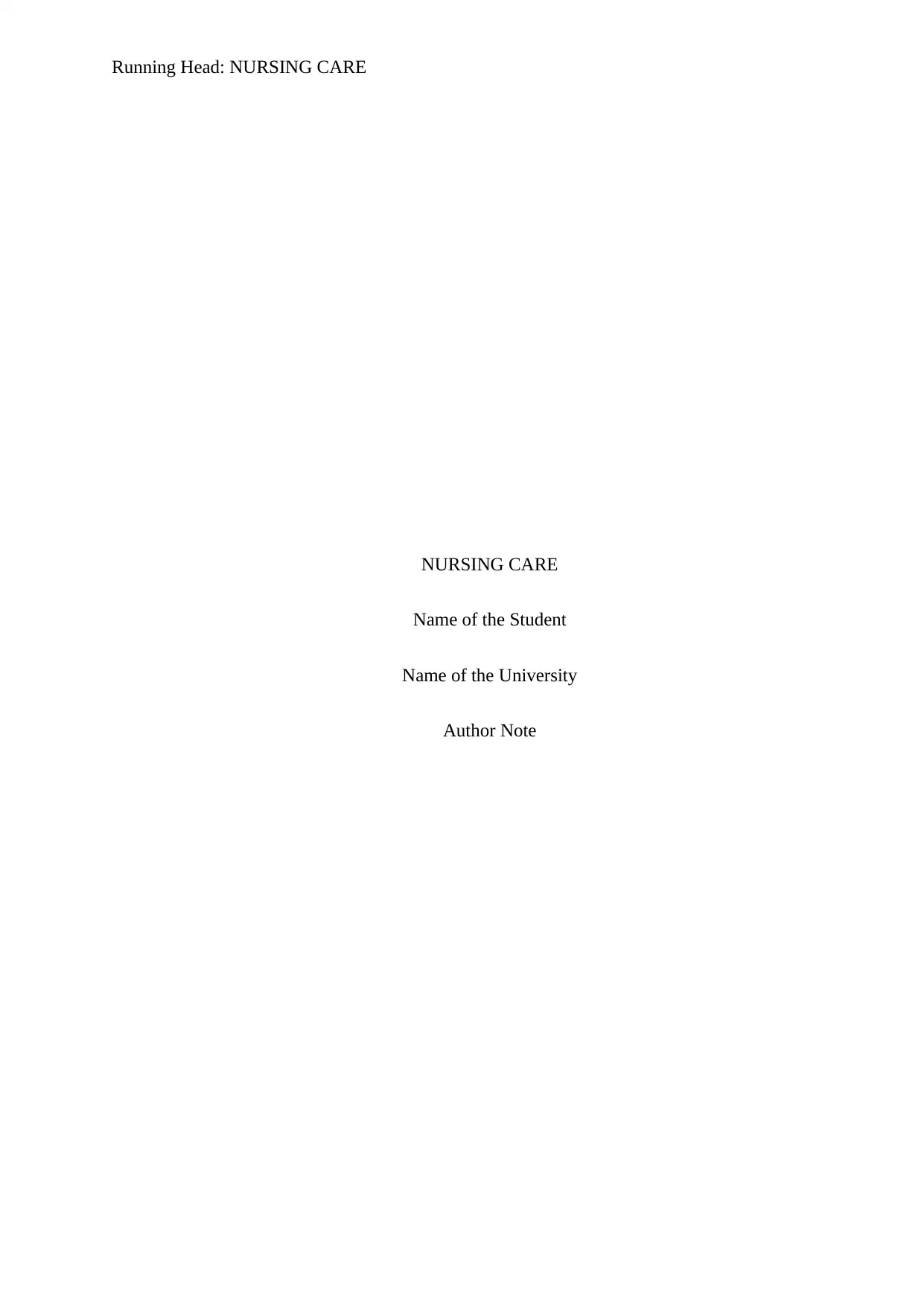
Running Head: NURSING CARE
NURSING CARE
Name of the Student
Name of the University
Author Note
NURSING CARE
Name of the Student
Name of the University
Author Note
Paraphrase This Document
Need a fresh take? Get an instant paraphrase of this document with our AI Paraphraser
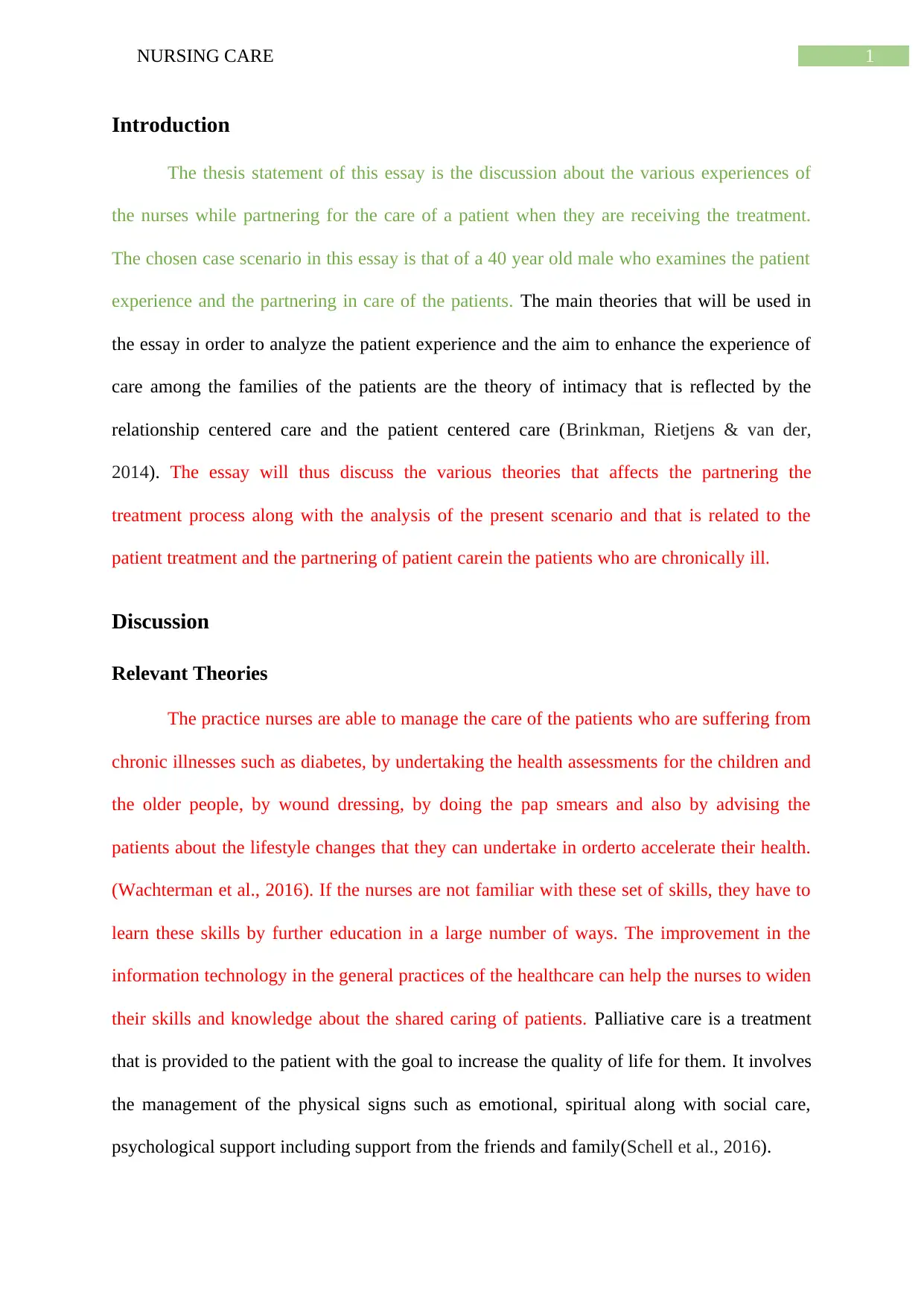
1NURSING CARE
Introduction
The thesis statement of this essay is the discussion about the various experiences of
the nurses while partnering for the care of a patient when they are receiving the treatment.
The chosen case scenario in this essay is that of a 40 year old male who examines the patient
experience and the partnering in care of the patients. The main theories that will be used in
the essay in order to analyze the patient experience and the aim to enhance the experience of
care among the families of the patients are the theory of intimacy that is reflected by the
relationship centered care and the patient centered care (Brinkman, Rietjens & van der,
2014). The essay will thus discuss the various theories that affects the partnering the
treatment process along with the analysis of the present scenario and that is related to the
patient treatment and the partnering of patient carein the patients who are chronically ill.
Discussion
Relevant Theories
The practice nurses are able to manage the care of the patients who are suffering from
chronic illnesses such as diabetes, by undertaking the health assessments for the children and
the older people, by wound dressing, by doing the pap smears and also by advising the
patients about the lifestyle changes that they can undertake in orderto accelerate their health.
(Wachterman et al., 2016). If the nurses are not familiar with these set of skills, they have to
learn these skills by further education in a large number of ways. The improvement in the
information technology in the general practices of the healthcare can help the nurses to widen
their skills and knowledge about the shared caring of patients. Palliative care is a treatment
that is provided to the patient with the goal to increase the quality of life for them. It involves
the management of the physical signs such as emotional, spiritual along with social care,
psychological support including support from the friends and family(Schell et al., 2016).
Introduction
The thesis statement of this essay is the discussion about the various experiences of
the nurses while partnering for the care of a patient when they are receiving the treatment.
The chosen case scenario in this essay is that of a 40 year old male who examines the patient
experience and the partnering in care of the patients. The main theories that will be used in
the essay in order to analyze the patient experience and the aim to enhance the experience of
care among the families of the patients are the theory of intimacy that is reflected by the
relationship centered care and the patient centered care (Brinkman, Rietjens & van der,
2014). The essay will thus discuss the various theories that affects the partnering the
treatment process along with the analysis of the present scenario and that is related to the
patient treatment and the partnering of patient carein the patients who are chronically ill.
Discussion
Relevant Theories
The practice nurses are able to manage the care of the patients who are suffering from
chronic illnesses such as diabetes, by undertaking the health assessments for the children and
the older people, by wound dressing, by doing the pap smears and also by advising the
patients about the lifestyle changes that they can undertake in orderto accelerate their health.
(Wachterman et al., 2016). If the nurses are not familiar with these set of skills, they have to
learn these skills by further education in a large number of ways. The improvement in the
information technology in the general practices of the healthcare can help the nurses to widen
their skills and knowledge about the shared caring of patients. Palliative care is a treatment
that is provided to the patient with the goal to increase the quality of life for them. It involves
the management of the physical signs such as emotional, spiritual along with social care,
psychological support including support from the friends and family(Schell et al., 2016).
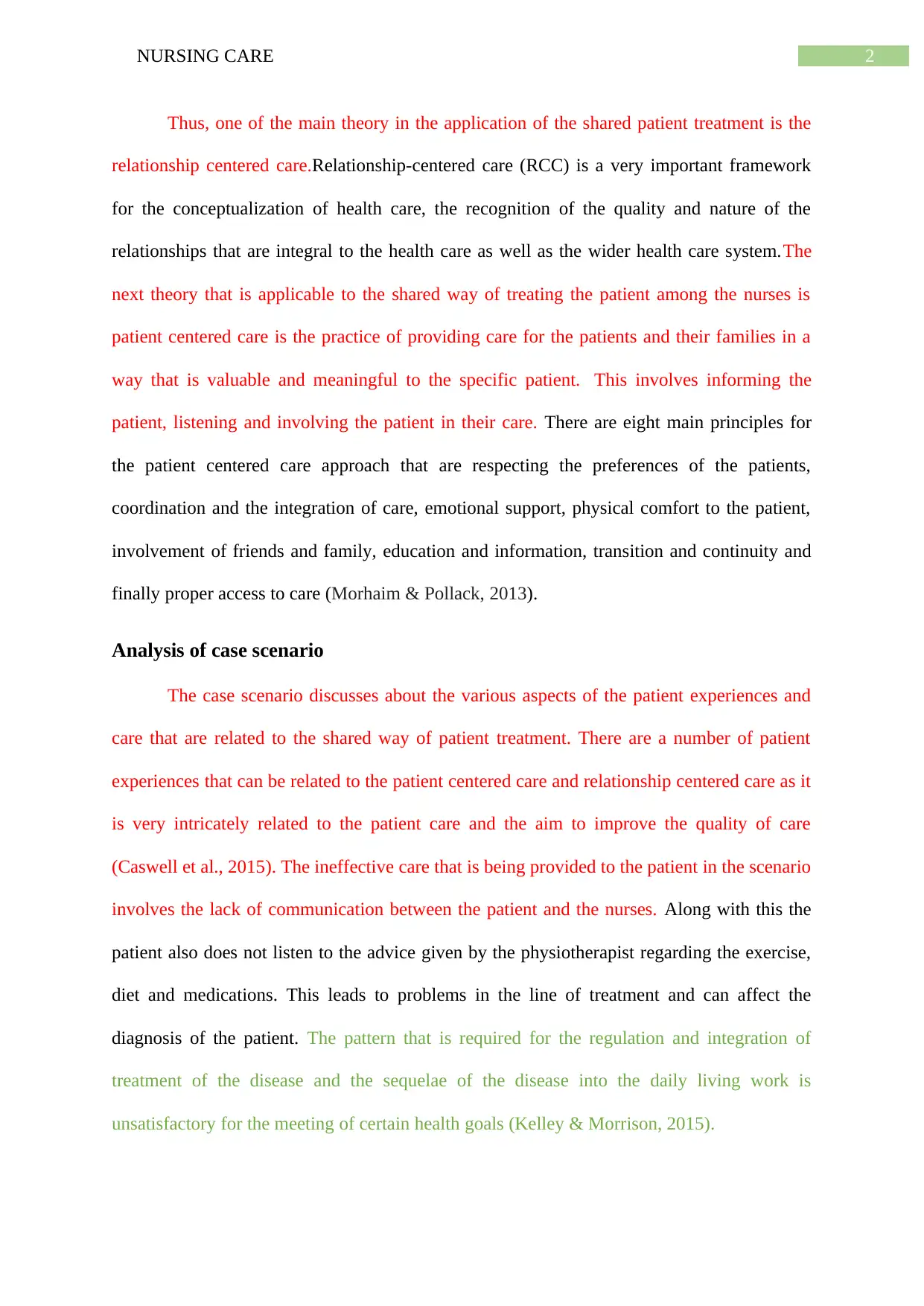
2NURSING CARE
Thus, one of the main theory in the application of the shared patient treatment is the
relationship centered care.Relationship-centered care (RCC) is a very important framework
for the conceptualization of health care, the recognition of the quality and nature of the
relationships that are integral to the health care as well as the wider health care system.The
next theory that is applicable to the shared way of treating the patient among the nurses is
patient centered care is the practice of providing care for the patients and their families in a
way that is valuable and meaningful to the specific patient. This involves informing the
patient, listening and involving the patient in their care. There are eight main principles for
the patient centered care approach that are respecting the preferences of the patients,
coordination and the integration of care, emotional support, physical comfort to the patient,
involvement of friends and family, education and information, transition and continuity and
finally proper access to care (Morhaim & Pollack, 2013).
Analysis of case scenario
The case scenario discusses about the various aspects of the patient experiences and
care that are related to the shared way of patient treatment. There are a number of patient
experiences that can be related to the patient centered care and relationship centered care as it
is very intricately related to the patient care and the aim to improve the quality of care
(Caswell et al., 2015). The ineffective care that is being provided to the patient in the scenario
involves the lack of communication between the patient and the nurses. Along with this the
patient also does not listen to the advice given by the physiotherapist regarding the exercise,
diet and medications. This leads to problems in the line of treatment and can affect the
diagnosis of the patient. The pattern that is required for the regulation and integration of
treatment of the disease and the sequelae of the disease into the daily living work is
unsatisfactory for the meeting of certain health goals (Kelley & Morrison, 2015).
Thus, one of the main theory in the application of the shared patient treatment is the
relationship centered care.Relationship-centered care (RCC) is a very important framework
for the conceptualization of health care, the recognition of the quality and nature of the
relationships that are integral to the health care as well as the wider health care system.The
next theory that is applicable to the shared way of treating the patient among the nurses is
patient centered care is the practice of providing care for the patients and their families in a
way that is valuable and meaningful to the specific patient. This involves informing the
patient, listening and involving the patient in their care. There are eight main principles for
the patient centered care approach that are respecting the preferences of the patients,
coordination and the integration of care, emotional support, physical comfort to the patient,
involvement of friends and family, education and information, transition and continuity and
finally proper access to care (Morhaim & Pollack, 2013).
Analysis of case scenario
The case scenario discusses about the various aspects of the patient experiences and
care that are related to the shared way of patient treatment. There are a number of patient
experiences that can be related to the patient centered care and relationship centered care as it
is very intricately related to the patient care and the aim to improve the quality of care
(Caswell et al., 2015). The ineffective care that is being provided to the patient in the scenario
involves the lack of communication between the patient and the nurses. Along with this the
patient also does not listen to the advice given by the physiotherapist regarding the exercise,
diet and medications. This leads to problems in the line of treatment and can affect the
diagnosis of the patient. The pattern that is required for the regulation and integration of
treatment of the disease and the sequelae of the disease into the daily living work is
unsatisfactory for the meeting of certain health goals (Kelley & Morrison, 2015).
⊘ This is a preview!⊘
Do you want full access?
Subscribe today to unlock all pages.

Trusted by 1+ million students worldwide
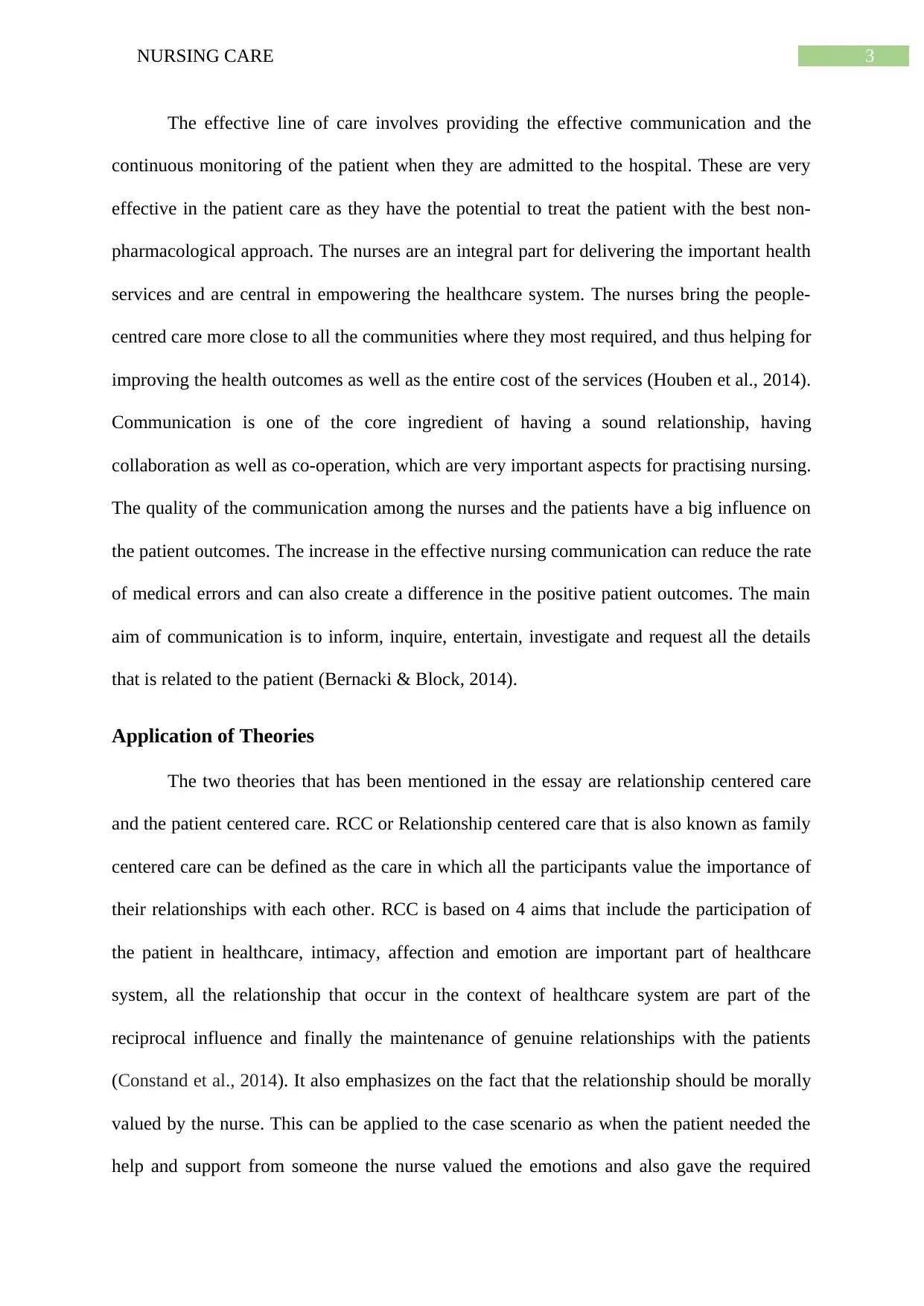
3NURSING CARE
The effective line of care involves providing the effective communication and the
continuous monitoring of the patient when they are admitted to the hospital. These are very
effective in the patient care as they have the potential to treat the patient with the best non-
pharmacological approach. The nurses are an integral part for delivering the important health
services and are central in empowering the healthcare system. The nurses bring the people-
centred care more close to all the communities where they most required, and thus helping for
improving the health outcomes as well as the entire cost of the services (Houben et al., 2014).
Communication is one of the core ingredient of having a sound relationship, having
collaboration as well as co-operation, which are very important aspects for practising nursing.
The quality of the communication among the nurses and the patients have a big influence on
the patient outcomes. The increase in the effective nursing communication can reduce the rate
of medical errors and can also create a difference in the positive patient outcomes. The main
aim of communication is to inform, inquire, entertain, investigate and request all the details
that is related to the patient (Bernacki & Block, 2014).
Application of Theories
The two theories that has been mentioned in the essay are relationship centered care
and the patient centered care. RCC or Relationship centered care that is also known as family
centered care can be defined as the care in which all the participants value the importance of
their relationships with each other. RCC is based on 4 aims that include the participation of
the patient in healthcare, intimacy, affection and emotion are important part of healthcare
system, all the relationship that occur in the context of healthcare system are part of the
reciprocal influence and finally the maintenance of genuine relationships with the patients
(Constand et al., 2014). It also emphasizes on the fact that the relationship should be morally
valued by the nurse. This can be applied to the case scenario as when the patient needed the
help and support from someone the nurse valued the emotions and also gave the required
The effective line of care involves providing the effective communication and the
continuous monitoring of the patient when they are admitted to the hospital. These are very
effective in the patient care as they have the potential to treat the patient with the best non-
pharmacological approach. The nurses are an integral part for delivering the important health
services and are central in empowering the healthcare system. The nurses bring the people-
centred care more close to all the communities where they most required, and thus helping for
improving the health outcomes as well as the entire cost of the services (Houben et al., 2014).
Communication is one of the core ingredient of having a sound relationship, having
collaboration as well as co-operation, which are very important aspects for practising nursing.
The quality of the communication among the nurses and the patients have a big influence on
the patient outcomes. The increase in the effective nursing communication can reduce the rate
of medical errors and can also create a difference in the positive patient outcomes. The main
aim of communication is to inform, inquire, entertain, investigate and request all the details
that is related to the patient (Bernacki & Block, 2014).
Application of Theories
The two theories that has been mentioned in the essay are relationship centered care
and the patient centered care. RCC or Relationship centered care that is also known as family
centered care can be defined as the care in which all the participants value the importance of
their relationships with each other. RCC is based on 4 aims that include the participation of
the patient in healthcare, intimacy, affection and emotion are important part of healthcare
system, all the relationship that occur in the context of healthcare system are part of the
reciprocal influence and finally the maintenance of genuine relationships with the patients
(Constand et al., 2014). It also emphasizes on the fact that the relationship should be morally
valued by the nurse. This can be applied to the case scenario as when the patient needed the
help and support from someone the nurse valued the emotions and also gave the required
Paraphrase This Document
Need a fresh take? Get an instant paraphrase of this document with our AI Paraphraser
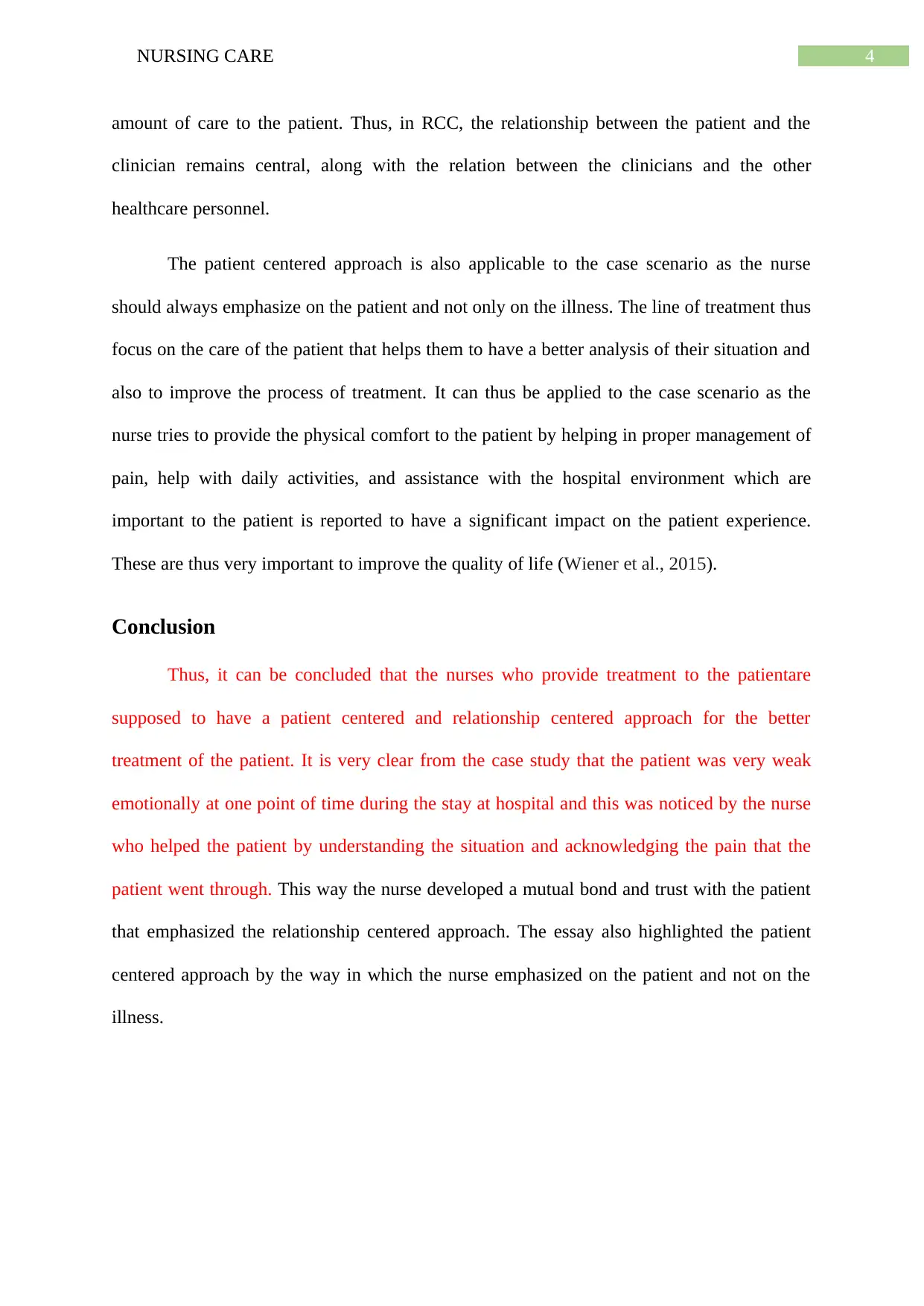
4NURSING CARE
amount of care to the patient. Thus, in RCC, the relationship between the patient and the
clinician remains central, along with the relation between the clinicians and the other
healthcare personnel.
The patient centered approach is also applicable to the case scenario as the nurse
should always emphasize on the patient and not only on the illness. The line of treatment thus
focus on the care of the patient that helps them to have a better analysis of their situation and
also to improve the process of treatment. It can thus be applied to the case scenario as the
nurse tries to provide the physical comfort to the patient by helping in proper management of
pain, help with daily activities, and assistance with the hospital environment which are
important to the patient is reported to have a significant impact on the patient experience.
These are thus very important to improve the quality of life (Wiener et al., 2015).
Conclusion
Thus, it can be concluded that the nurses who provide treatment to the patientare
supposed to have a patient centered and relationship centered approach for the better
treatment of the patient. It is very clear from the case study that the patient was very weak
emotionally at one point of time during the stay at hospital and this was noticed by the nurse
who helped the patient by understanding the situation and acknowledging the pain that the
patient went through. This way the nurse developed a mutual bond and trust with the patient
that emphasized the relationship centered approach. The essay also highlighted the patient
centered approach by the way in which the nurse emphasized on the patient and not on the
illness.
amount of care to the patient. Thus, in RCC, the relationship between the patient and the
clinician remains central, along with the relation between the clinicians and the other
healthcare personnel.
The patient centered approach is also applicable to the case scenario as the nurse
should always emphasize on the patient and not only on the illness. The line of treatment thus
focus on the care of the patient that helps them to have a better analysis of their situation and
also to improve the process of treatment. It can thus be applied to the case scenario as the
nurse tries to provide the physical comfort to the patient by helping in proper management of
pain, help with daily activities, and assistance with the hospital environment which are
important to the patient is reported to have a significant impact on the patient experience.
These are thus very important to improve the quality of life (Wiener et al., 2015).
Conclusion
Thus, it can be concluded that the nurses who provide treatment to the patientare
supposed to have a patient centered and relationship centered approach for the better
treatment of the patient. It is very clear from the case study that the patient was very weak
emotionally at one point of time during the stay at hospital and this was noticed by the nurse
who helped the patient by understanding the situation and acknowledging the pain that the
patient went through. This way the nurse developed a mutual bond and trust with the patient
that emphasized the relationship centered approach. The essay also highlighted the patient
centered approach by the way in which the nurse emphasized on the patient and not on the
illness.
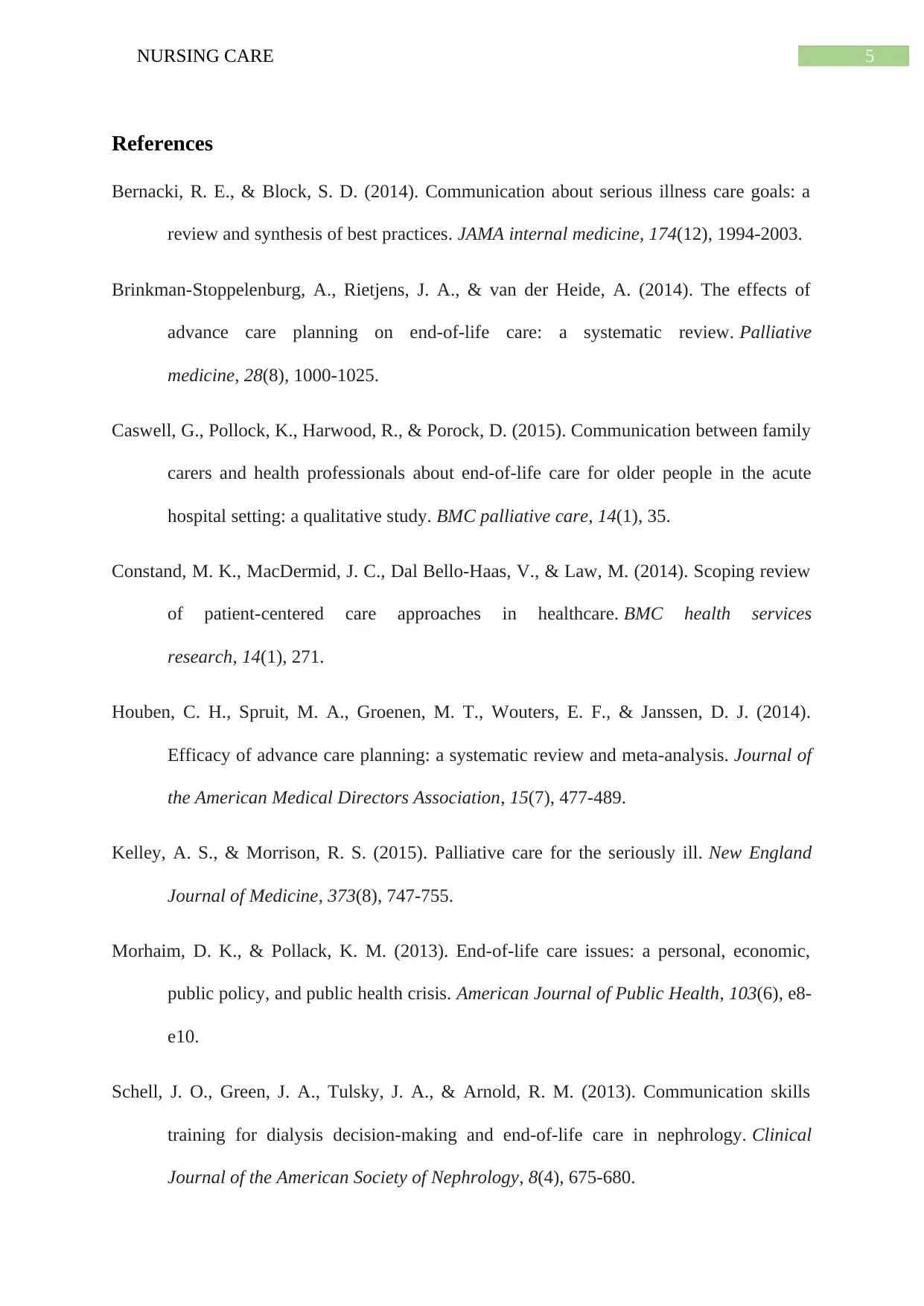
5NURSING CARE
References
Bernacki, R. E., & Block, S. D. (2014). Communication about serious illness care goals: a
review and synthesis of best practices. JAMA internal medicine, 174(12), 1994-2003.
Brinkman-Stoppelenburg, A., Rietjens, J. A., & van der Heide, A. (2014). The effects of
advance care planning on end-of-life care: a systematic review. Palliative
medicine, 28(8), 1000-1025.
Caswell, G., Pollock, K., Harwood, R., & Porock, D. (2015). Communication between family
carers and health professionals about end-of-life care for older people in the acute
hospital setting: a qualitative study. BMC palliative care, 14(1), 35.
Constand, M. K., MacDermid, J. C., Dal Bello-Haas, V., & Law, M. (2014). Scoping review
of patient-centered care approaches in healthcare. BMC health services
research, 14(1), 271.
Houben, C. H., Spruit, M. A., Groenen, M. T., Wouters, E. F., & Janssen, D. J. (2014).
Efficacy of advance care planning: a systematic review and meta-analysis. Journal of
the American Medical Directors Association, 15(7), 477-489.
Kelley, A. S., & Morrison, R. S. (2015). Palliative care for the seriously ill. New England
Journal of Medicine, 373(8), 747-755.
Morhaim, D. K., & Pollack, K. M. (2013). End-of-life care issues: a personal, economic,
public policy, and public health crisis. American Journal of Public Health, 103(6), e8-
e10.
Schell, J. O., Green, J. A., Tulsky, J. A., & Arnold, R. M. (2013). Communication skills
training for dialysis decision-making and end-of-life care in nephrology. Clinical
Journal of the American Society of Nephrology, 8(4), 675-680.
References
Bernacki, R. E., & Block, S. D. (2014). Communication about serious illness care goals: a
review and synthesis of best practices. JAMA internal medicine, 174(12), 1994-2003.
Brinkman-Stoppelenburg, A., Rietjens, J. A., & van der Heide, A. (2014). The effects of
advance care planning on end-of-life care: a systematic review. Palliative
medicine, 28(8), 1000-1025.
Caswell, G., Pollock, K., Harwood, R., & Porock, D. (2015). Communication between family
carers and health professionals about end-of-life care for older people in the acute
hospital setting: a qualitative study. BMC palliative care, 14(1), 35.
Constand, M. K., MacDermid, J. C., Dal Bello-Haas, V., & Law, M. (2014). Scoping review
of patient-centered care approaches in healthcare. BMC health services
research, 14(1), 271.
Houben, C. H., Spruit, M. A., Groenen, M. T., Wouters, E. F., & Janssen, D. J. (2014).
Efficacy of advance care planning: a systematic review and meta-analysis. Journal of
the American Medical Directors Association, 15(7), 477-489.
Kelley, A. S., & Morrison, R. S. (2015). Palliative care for the seriously ill. New England
Journal of Medicine, 373(8), 747-755.
Morhaim, D. K., & Pollack, K. M. (2013). End-of-life care issues: a personal, economic,
public policy, and public health crisis. American Journal of Public Health, 103(6), e8-
e10.
Schell, J. O., Green, J. A., Tulsky, J. A., & Arnold, R. M. (2013). Communication skills
training for dialysis decision-making and end-of-life care in nephrology. Clinical
Journal of the American Society of Nephrology, 8(4), 675-680.
⊘ This is a preview!⊘
Do you want full access?
Subscribe today to unlock all pages.

Trusted by 1+ million students worldwide
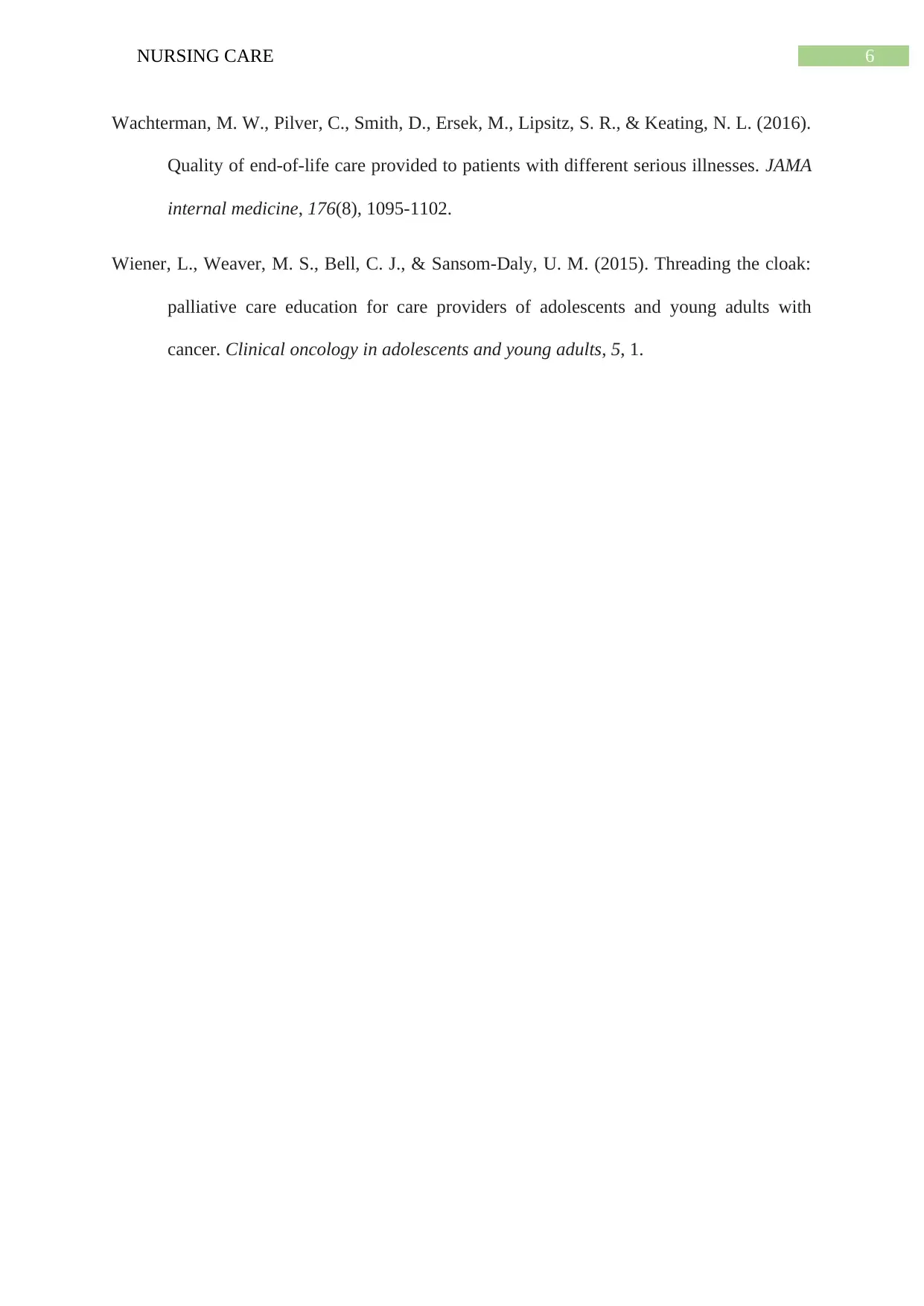
6NURSING CARE
Wachterman, M. W., Pilver, C., Smith, D., Ersek, M., Lipsitz, S. R., & Keating, N. L. (2016).
Quality of end-of-life care provided to patients with different serious illnesses. JAMA
internal medicine, 176(8), 1095-1102.
Wiener, L., Weaver, M. S., Bell, C. J., & Sansom-Daly, U. M. (2015). Threading the cloak:
palliative care education for care providers of adolescents and young adults with
cancer. Clinical oncology in adolescents and young adults, 5, 1.
Wachterman, M. W., Pilver, C., Smith, D., Ersek, M., Lipsitz, S. R., & Keating, N. L. (2016).
Quality of end-of-life care provided to patients with different serious illnesses. JAMA
internal medicine, 176(8), 1095-1102.
Wiener, L., Weaver, M. S., Bell, C. J., & Sansom-Daly, U. M. (2015). Threading the cloak:
palliative care education for care providers of adolescents and young adults with
cancer. Clinical oncology in adolescents and young adults, 5, 1.
1 out of 7
Related Documents
Your All-in-One AI-Powered Toolkit for Academic Success.
+13062052269
info@desklib.com
Available 24*7 on WhatsApp / Email
![[object Object]](/_next/static/media/star-bottom.7253800d.svg)
Unlock your academic potential
Copyright © 2020–2025 A2Z Services. All Rights Reserved. Developed and managed by ZUCOL.





